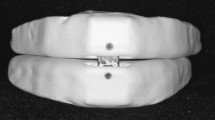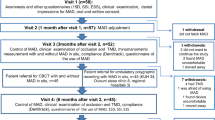Abstract
Background: The mandibular advancement device (MAD) is accepted as an additional treatment option for snoring and mild obstructive sleep disorders. Its therapeutic efficacy can only be verified through nocturnal polysomnography with the appliance in situ. The relevance of the craniofacial skeletal and soft-tissue structures as an etiological cofactor is controversial. While the lateral cephalogram of the facial skeleton is of no direct diagnostic relevance, it remains unclear to what extent cephalometric assessment can provide prognostic information to better ensure treatment success with an MAD.
Methods and Results: This study is based on the evaluation of 57 patients diagnosed polysomnographically with obstructive sleep apnea (OSA). The patients were treated primarily with a modified activator; after 6–12 weeks, control polysomnography was carried out in the sleep laboratory. The cephalometric variables were analyzed using a multivariate regression procedure with the response variable of treatment outcome.
In addition to a horizontal craniofacial morphology, the downward and forward posture of the hyoid is a prognostic variable for effective therapy with an MAD.
Zusammenfassung
Hintergrund: Intraorale Protrusionsgeräte (IPG) gelten als eine Therapiemodalität bei Schnarchen und leichten obstruktiven Schlafstörungen. Der therapeutische Effekt dieser Therapieform kann zurzeit ausschließlich in einer nächtlichen Polysomnogrphie mit dem Gerät in situ beurteilt werden. Die Bedeutung der skelettalen und weichteiligen Strukturen des Gesichtsschädels als ätiologischer Kofaktor von nächtlichen obstruktiven Atemregulationsstörungen ist umstritten. Während die Fernröntgenseitenaufnahme des Gesichtsschädels der Forderung nach einer unmittelbaren diagnostischen Relevanz nicht gerecht wird, ist es gegenwärtig ungeklärt, inwiefern mit der Kephalometrie eine prognostische Aussage zum Therapieeffekt bei der Behandlung mit einem IPG getroffen werden kann.
Methoden und Ergebnisse: Die Studie basiert auf der Untersuchung von 57 Patienten mit der polysomnographisch gestellten Diagnose einer obstruktiven Schlafapnoe (OSA). Die Patienten wurden mit einem modifizierten Aktivator primär therapiert. Nach 6–12 Wochen wurde eine Kontrollpolysomnographie im Schlaflabor durchgeführt. Die kephalometrischen Parameter wurden in einer multivarianten Regressionsanalyse zur Kriteriumsvariablen des erzielten therapeutischen Erfolges untersucht.
Neben einem horizontalen Gesichtsschädelaufbau ist eine kaudoventraele Position des Hyoids ein prognostisch positiver Parameter für eine erfolgreiche Therapie mit einem IPG.
Similar content being viewed by others
Author information
Authors and Affiliations
Additional information
Received: October 27, 2000; accepted: November 20, 2001
Rights and permissions
About this article
Cite this article
Rose, E., Lehner, M., Staats, R. et al. Cephalometric Analysis in Patients with Obstructive Sleep Apnea Part II: Prognostic Value in Treatment with a Mandibular Advancement Device. Journal of Orofacial Orthopedics / Fortschritte der Kieferorthopädie 63, 315–324 (2002). https://doi.org/10.1007/s00056-002-0058-9
Issue Date:
DOI: https://doi.org/10.1007/s00056-002-0058-9




